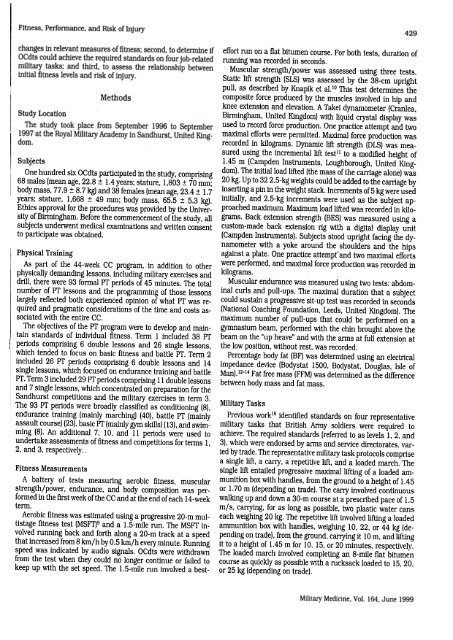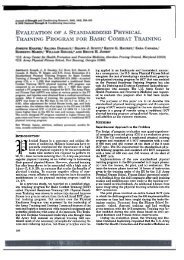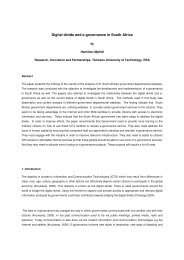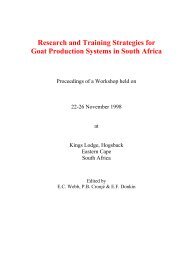Fitness, Performance, and Risk of Injury in British Army Officer Cadets
Fitness, Performance, and Risk of Injury in British Army Officer Cadets
Fitness, Performance, and Risk of Injury in British Army Officer Cadets
You also want an ePaper? Increase the reach of your titles
YUMPU automatically turns print PDFs into web optimized ePapers that Google loves.
I<br />
<strong>Fitness</strong>. Military<br />
Perfonnance, <strong>and</strong> <strong>Risk</strong> <strong>of</strong> <strong>Injury</strong><br />
changes <strong>in</strong> relevant measures <strong>of</strong> fitness; second, to detenn<strong>in</strong>e if<br />
OCdts could achieve the required st<strong>and</strong>ards on four job-related<br />
military tasks; <strong>and</strong> third, to assess the relationship between<br />
<strong>in</strong>itial fitness levels <strong>and</strong> lisk <strong>of</strong> <strong>in</strong>jury.<br />
Methods<br />
Study Location<br />
The study took place from September 1996 to September<br />
1997 at the Royal Military Academy <strong>in</strong> S<strong>and</strong>hurst, United K<strong>in</strong>gdom.<br />
Subjects<br />
One hundred six OCdts participated <strong>in</strong> the study, compris<strong>in</strong>g<br />
68 males (mean age, 22.8 :t: 1.4 years; stature, 1,803 :t: 70 rom;<br />
body mass, 77.9 :t: 8.7 kg) <strong>and</strong> 38 females (mean age, 23.4 :t: 1.7<br />
years; stature, 1,668 :t: 49 mm; body mass, 65.5 :t: 5.3 kg).<br />
Ethics approval for the procedures was provided by the Univer-<br />
sity <strong>of</strong> Birm<strong>in</strong>gham. Before the commencement <strong>of</strong> the study, all<br />
subjects underwent medical exam<strong>in</strong>ations <strong>and</strong> written consent<br />
to participate was obta<strong>in</strong>ed.<br />
Physical Tra<strong>in</strong><strong>in</strong>g<br />
As part <strong>of</strong> the 44-week CC program, <strong>in</strong> addition to other<br />
physically dem<strong>and</strong><strong>in</strong>g lessons, <strong>in</strong>clud<strong>in</strong>g military exercises <strong>and</strong><br />
drill, there were 93 formal JYr periods <strong>of</strong> 45 m<strong>in</strong>utes. The total<br />
number <strong>of</strong> JYr lessons <strong>and</strong> the programm<strong>in</strong>g <strong>of</strong> those lessons<br />
largely reflected both experienced op<strong>in</strong>ion <strong>of</strong> what JYr was required<br />
<strong>and</strong> pragmatic considerations <strong>of</strong> the time <strong>and</strong> costs associated<br />
with the entire CC.<br />
The objectives <strong>of</strong> the JYr program were to develop <strong>and</strong> ma<strong>in</strong>ta<strong>in</strong><br />
st<strong>and</strong>ards <strong>of</strong> <strong>in</strong>dividual fitness. Term I <strong>in</strong>cluded 38 JYr<br />
periods compris<strong>in</strong>g 6 double lessons <strong>and</strong> 26 s<strong>in</strong>gle lessons,<br />
which tended to focus on basic fitness <strong>and</strong> battle JYr. Term 2<br />
<strong>in</strong>cluded 26 JYr periods compris<strong>in</strong>g 6 double lessons <strong>and</strong> 14<br />
s<strong>in</strong>gle lessons, which focused on endurance tra<strong>in</strong><strong>in</strong>g <strong>and</strong> battle<br />
JYr. Term 3 <strong>in</strong>cluded 29 JYr periods compris<strong>in</strong>g II double lessons<br />
<strong>and</strong> 7 s<strong>in</strong>gle lessons, which concentrated on preparation for the<br />
S<strong>and</strong>hurst competitions <strong>and</strong> the military exercises <strong>in</strong> term 3.<br />
I The 93 JYr periods were broadly classified as condition<strong>in</strong>g (8),<br />
! endurance tra<strong>in</strong><strong>in</strong>g (ma<strong>in</strong>ly march<strong>in</strong>g) (40), battle JYr (ma<strong>in</strong>ly<br />
I assault course) (23), basic JYr (ma<strong>in</strong>ly gym skills) (13), <strong>and</strong> swim-<br />
429<br />
effort run on a flat bitumen course. For both tests, duration <strong>of</strong><br />
runn<strong>in</strong>g was recorded <strong>in</strong> seconds.<br />
Muscular strength/power was assessed us<strong>in</strong>g three tests.<br />
Static lift strength (SLS) was assessed by the 38-cm upright<br />
pull, as described by Knapik et al.IO This test determ<strong>in</strong>es the<br />
composite force produced by the muscles <strong>in</strong>volved <strong>in</strong> hip <strong>and</strong><br />
knee extension <strong>and</strong> elevation. A Takei dynamometer (Cranlea,<br />
Birm<strong>in</strong>gham, United K<strong>in</strong>gdom) with liquid crystal display was<br />
used to record force production. One practice attempt <strong>and</strong> two<br />
maximal efforts were permitted. Maximal force production was<br />
recorded <strong>in</strong> kilograms. Dynamic lift strength (DLS) was measured<br />
us<strong>in</strong>g the <strong>in</strong>cremental lift tesVI to a modified height <strong>of</strong><br />
1.45 m (Campden Instruments, Loughborough, United K<strong>in</strong>gdom).<br />
The <strong>in</strong>itial load lifted (the mass <strong>of</strong> the carriage alone) was<br />
20 kg. Up to 32 2.5-kgweights could be added to the carriage by<br />
<strong>in</strong>sert<strong>in</strong>g a p<strong>in</strong> <strong>in</strong> the weight stack. Increments <strong>of</strong> 5 kg were used<br />
<strong>in</strong>itially, <strong>and</strong> 2.5-kg <strong>in</strong>crements were used as the subject approached<br />
maximum. Maximum load lifted was recorded <strong>in</strong> kilograms.<br />
Back extension strength (BES) was measured us<strong>in</strong>g a<br />
custom-made back extension rig with a digital display unit<br />
(Campden Instruments). Subjects stood upright fac<strong>in</strong>g the dynamometer<br />
with a yoke around the shoulders <strong>and</strong> the hips<br />
aga<strong>in</strong>st a plate. One practice attempt-<strong>and</strong> two maximal efforts<br />
were performed, <strong>and</strong> maximal force production was recorded <strong>in</strong><br />
kilograms.<br />
Muscular endurance was measured us<strong>in</strong>g two tests: abdom<strong>in</strong>al<br />
curls <strong>and</strong> pull-ups. The maximal duration that a subject<br />
could susta<strong>in</strong> a progressive sit-up test was recorded <strong>in</strong> seconds<br />
(National Coach<strong>in</strong>g Foundation, Leeds, United K<strong>in</strong>gdom). The<br />
maximum number <strong>of</strong> pull-ups that could be performed on a<br />
gymnasium beam, performed with the ch<strong>in</strong> brought above the<br />
beam on the "up heave" <strong>and</strong> with the arms at full extension at<br />
the low position, without rest, was recorded.<br />
Percentage body fat (BF) was determ<strong>in</strong>ed us<strong>in</strong>g an electrical<br />
impedance device (Bodystat 1500, Bodystat, Douglas, Isle <strong>of</strong><br />
Man). 12-14 Fat free mass (FFM) was determ<strong>in</strong>ed as the difference<br />
between body mass <strong>and</strong> fat mass.<br />
Military Tasks<br />
Previous work15 identified st<strong>and</strong>ards on four representative<br />
military tasks that <strong>British</strong> Amy soldiers were required to<br />
m<strong>in</strong>g (8). An additional 7, 10, <strong>and</strong> 11 periods were used to achieve. The required st<strong>and</strong>ards (referred to as levels 1.2. <strong>and</strong><br />
undertake assessments <strong>of</strong> fitness <strong>and</strong> competitions for terms I,<br />
2, <strong>and</strong> 3, respectively..<br />
3). which were endorsed by arms <strong>and</strong> service directorates. varied<br />
by trade. The representative military task protocols comprise<br />
a s<strong>in</strong>gle lift. a carry. a repetitive lift. <strong>and</strong> a loaded march. The<br />
<strong>Fitness</strong> Measurements<br />
s<strong>in</strong>gle lift entailed progressive maximal lift<strong>in</strong>g <strong>of</strong> a loaded am-<br />
A battery <strong>of</strong> tests measur<strong>in</strong>g aerobic fitness, muscular munition box with h<strong>and</strong>les. from the ground to a height <strong>of</strong> 1.45<br />
strength/power, endurance. <strong>and</strong> body composition was per- or 1.70 m (depend<strong>in</strong>g on trade). The carry <strong>in</strong>volved cont<strong>in</strong>uous<br />
formed <strong>in</strong> the first week <strong>of</strong> the CC <strong>and</strong> at the end <strong>of</strong> each 14-week walk<strong>in</strong>g up <strong>and</strong> down a 30-m course at a prescribed pace <strong>of</strong> 1.5<br />
term.<br />
m/s. carry<strong>in</strong>g. for as long as possible. two plastic water cans<br />
Aerobic fitness was estimated us<strong>in</strong>g a progressive 20-m mul- each weigh<strong>in</strong>g 20 kg. The repetitive lift <strong>in</strong>volved lift<strong>in</strong>g a loaded<br />
tistage fitness test (MSFT)9 <strong>and</strong> a 1.5-mile run. The MSFT <strong>in</strong>-volved ammunition box with h<strong>and</strong>les. weigh<strong>in</strong>g 10. 22. or 44 kg (de-<br />
runn<strong>in</strong>g back <strong>and</strong> forth along a 20-m track at a speed pend<strong>in</strong>g on trade). from the ground. carry<strong>in</strong>g it 10 m. <strong>and</strong> lift<strong>in</strong>g<br />
that <strong>in</strong>creased from 8 km/h by 0.5 km/h every m<strong>in</strong>ute. Runn<strong>in</strong>g it to a height <strong>of</strong> 1.45 m for 10. 15. or 20 m<strong>in</strong>utes. respectively.<br />
speed was <strong>in</strong>dicated by audio signals. OCdts were withdrawnfrom The loaded march <strong>in</strong>volved complet<strong>in</strong>g an B-mile flat bitumen<br />
the test when they could no longer cont<strong>in</strong>ue or failed tokeep course as quickly as possible \\ith a rucksack loaded to 15. 20.<br />
up with the set speed. The 1.5-mile run <strong>in</strong>volved a best- or 25 kg (depend<strong>in</strong>g on trade).<br />
Medic<strong>in</strong>e, Vol. 164. June 1999
















